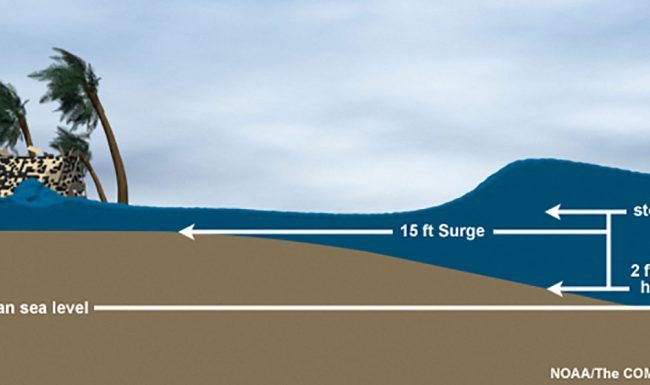Blog
Media Contact
Email: media@floodpanel.com

Storm Surge 101
Click graphic above to enlarge: Storm surge is an abnormal rise of water generated by a storm, over and above the predicted astronomical tides. Storm surge should not be confused with storm tide, which is defined as the water level rise due to the combination of storm surge and the astronomical tide. This rise in water level can cause extreme flooding in coastal areas particularly when storm surge coincides with normal high tide, resulting in storm tides reaching up to 20 feet or more in some cases. Source: https://www.nhc.noaa.gov/surge/
We have mentioned the phenomenon of storm surge many times in this blog series, and now storm surge is again in the news with the arrival of hurricane after hurricane during this record-setting year. But what exactly is storm surge, and why is it so dangerous?
The simplest explanation is that storm surge is the sudden rise in sea level that happens during a hurricane, cyclone, or a particularly powerful storm. Although it is often described as a ‘wall of water’ in news accounts, it rarely appears this way in reality. Most often, the sea water will arrive with the winds of the hurricane, pushed forward by the gusts. The speed at which the water level rises can be astonishing, and this is why storm surges are so dangerous. At one moment, a person can be standing on dry land- in a location thought to be well inland from the sea- and at the next moment the person finds themselves waist deep in swirling, debris-filled seawater. This can happen with incredible speed and suddenness!
Many people do not understand this hazard, even those who may have lived near the coastline all their lives. When unprepared people hear that a 6-foot storm surge is expected, they often envision that the usual high tide mark will be extended by six feet. They erroneously picture the normal coastline, but just six feet higher into the beach zone. This can be a deadly mistake, because a 6’ storm surge means something far more dangerous!
To get a more accurate picture of a storm surge, you would need to know that a 6’ storm surge means that water will cover a given area to a DEPTH of 6’. The actual spatial incursion of the storm surge depends on many factors such as topography, obstacles, wind direction, and other variables. In general, meteorologists produce storm surge charts that can indicate how far inland this 6’-deep surge will extend, so that people can evacuate in a timely manner.
Evacuation is the only safe choice in a zone where a large storm surge is predicted. Taking our example of the 6’ storm surge, let’s imagine being confronted by the very sudden arrival of a six foot depth of water. A cubic yard of water weighs over 1,700 pounds, so a 6’ surge introduces twice that much- over 3400 pounds of water pushing its way towards you, your car, or your house. Even a very well built house on a fortified foundation can have trouble withstanding that amount of force. A person on foot has no chance at all to resist, and even a sturdy SUV will soon topple. In fact, most vehicles have trouble withstanding even a 1’ surge of water.
Clearly, the best plan of action is to evacuate as soon as possible when a storm surge is predicted. The surge can arrive well ahead of the hurricane ‘making landfall’, at times arriving a day or more before the actual storm. Waiting to ‘see what happens’ only means that you will lose precious time to make your escape, during a time when many other vehicles will be clogging the escape routes. Many people think that the forceful gales of the hurricane are the thing to be feared, but in fact it is the storm surge that kills that vast majority of storm victims who live near the coastline. For this reason, it is critically important to consult the reports- not only for expected landfall times- but also for the expected storm surge zones. Having important belongings and documents collected and packed, having a ‘go bag’ by the door, securing pets in carriers, bringing food, lots of clean water, clothing, toiletries, and bedding for everyone in the house- these are all tasks that need to be completed well ahead of a hurricane, because the most dangerous part of the hurricane may well arrive a day or two before the hurricane itself.

